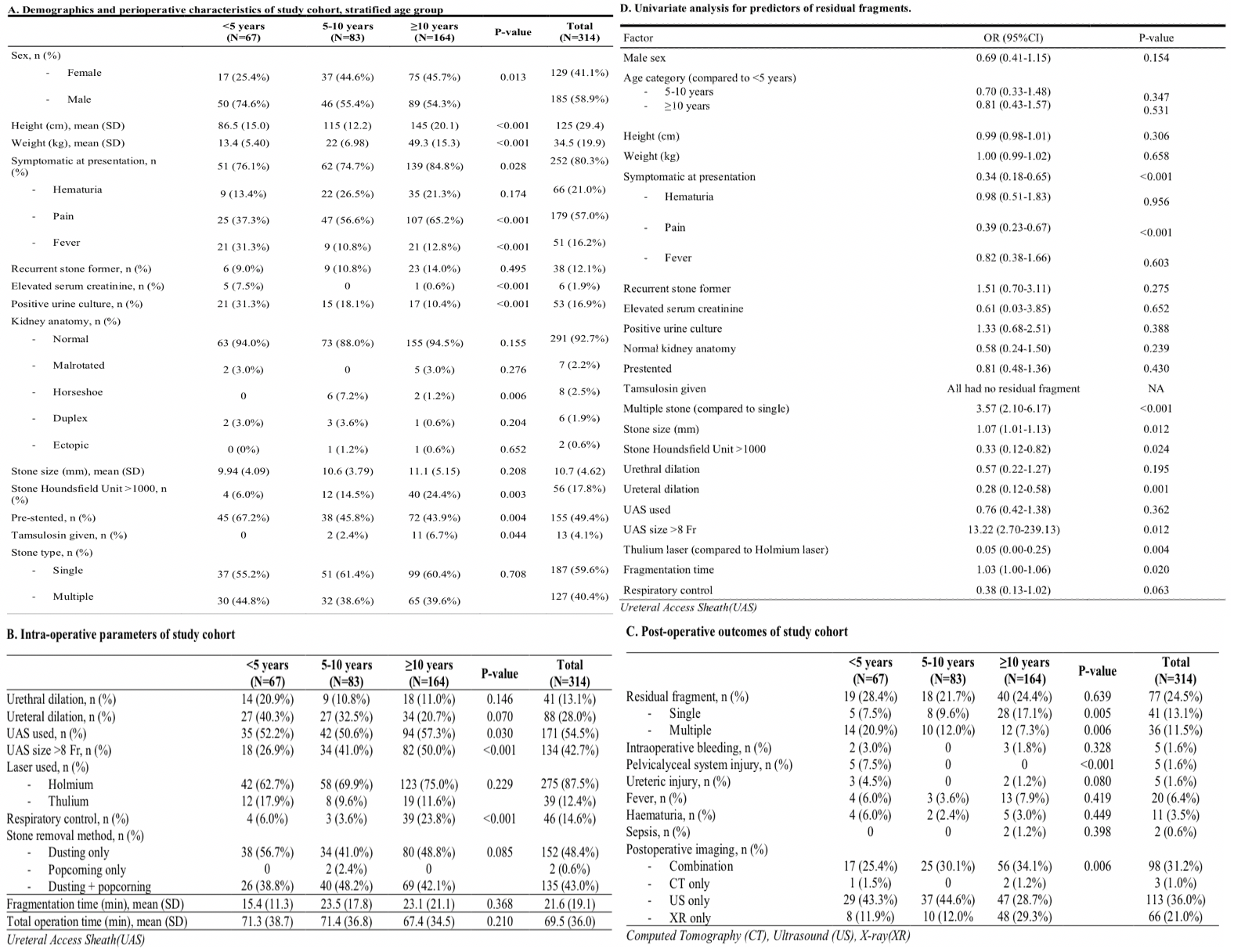Back
Poster, Podium & Video Sessions
Moderated Poster
MP17: Pediatric Urology: Upper & Lower Urinary Tract
MP17-09: Outcomes and lessons learnt from practice of retrograde intrarenal surgery (RIRS) in a paediatric setting of various age groups: A global study across 8 centres
Friday, May 13, 2022
4:30 PM – 5:45 PM
Location: Room 225
Ee Jean Lim*, Singapore, Singapore, Olivier Traxer, Paris, France, Yesica Quiroz Madarriaga, Barcelona, Spain, Daniele Castellani, Ancona, Italy, Khi Yung Fong, Singapore, Singapore, Vinson Wai Shun Chan, Leeds, United Kingdom, Anna Bujons Tur, Barcelona, Spain, Amelia Pietropaolo, Southamptom, United Kingdom, Deepak Ragoori, Banjara Hills, India, Anil Shrestha, Kathmandu , Nepal, Chandra Mohan Vaddi, Hyderabad, India, Tanuj Paul Bhatia, Haryana, India, Mriganka Mani, Patrick Juliebø-Jones, Stephen Griffin, Southamptom, United Kingdom, Esther García Rojo, Madrid, Spain, Mariela Corrales, Paris, France, Cagri Akin Sekerci, Yiloren Tanidir, Istanbul, Turkey, Jeremy Yuen-Chun Teoh, Hong Kong , China, People's Republic of, Vineet Gauhar, Singapore, Singapore, Bhaskar Kumar Somani, Southampton, United Kingdom
- EL
Poster Presenter(s)
Introduction: We aim to analyse and report the practice, outcomes and lessons learnt from a global series of retrograde intrarenal surgery (RIRS) in a paediatric multicentre series.
Methods: Retrospective review of anonymised pooled data gathered globally from 8 centres in paediatric patients (=18 years of age) who had renal stones and underwent RIRS from 2015 to 2020 was performed. Patient demographics, perioperative parameters, stone characteristics, complications and stone-free rate (SFR) were analysed. Residual fragments(RFs) were defined as a single fragment >2mm or multiple fragments. Our cohort was stratified by age into 3 groups: =5 years (Group A), 5-10 years (Group B) and =10 years (Group C). T-test and Mann–Whitney were used for continuous variables. Categorical data between groups were analysed using the ?2 test.
Results: 314 patients were included for analysis. Mean age was 9.54 +/- 4.76 years. The number of patients in groups A, B and C were 67 (21.3%), 83 (26.4%) and 164 (52.2%) respectively. The mean stone size was 10.7 +/- 4.62 mm. While pre-stenting was performed in 155 (49.4%) of patients, ureteral access sheaths (UAS) was used in 54.5% of patients, and majority (71%) utilizing holmium laser for stone fragmentation. The SFR was 75.5% with 77(24.5%) having residual fragments. All post-surgical complications were minor Clavein Dindo (CD) classification and included ureteric injury (n=5), pelvicalyceal injury (n=5, all in group A), fever (n=20), hematuria (n=11) and sepsis (n=2).
Conclusions: RIRS is acceptable as a firstline intervention in the paediatric population with reasonable efficacy and low morbidity; Complications are slightly higher in Group A and this should be taken into account while counselling patients.
Source of Funding: NA

Methods: Retrospective review of anonymised pooled data gathered globally from 8 centres in paediatric patients (=18 years of age) who had renal stones and underwent RIRS from 2015 to 2020 was performed. Patient demographics, perioperative parameters, stone characteristics, complications and stone-free rate (SFR) were analysed. Residual fragments(RFs) were defined as a single fragment >2mm or multiple fragments. Our cohort was stratified by age into 3 groups: =5 years (Group A), 5-10 years (Group B) and =10 years (Group C). T-test and Mann–Whitney were used for continuous variables. Categorical data between groups were analysed using the ?2 test.
Results: 314 patients were included for analysis. Mean age was 9.54 +/- 4.76 years. The number of patients in groups A, B and C were 67 (21.3%), 83 (26.4%) and 164 (52.2%) respectively. The mean stone size was 10.7 +/- 4.62 mm. While pre-stenting was performed in 155 (49.4%) of patients, ureteral access sheaths (UAS) was used in 54.5% of patients, and majority (71%) utilizing holmium laser for stone fragmentation. The SFR was 75.5% with 77(24.5%) having residual fragments. All post-surgical complications were minor Clavein Dindo (CD) classification and included ureteric injury (n=5), pelvicalyceal injury (n=5, all in group A), fever (n=20), hematuria (n=11) and sepsis (n=2).
Conclusions: RIRS is acceptable as a firstline intervention in the paediatric population with reasonable efficacy and low morbidity; Complications are slightly higher in Group A and this should be taken into account while counselling patients.
Source of Funding: NA


.jpg)
.jpg)